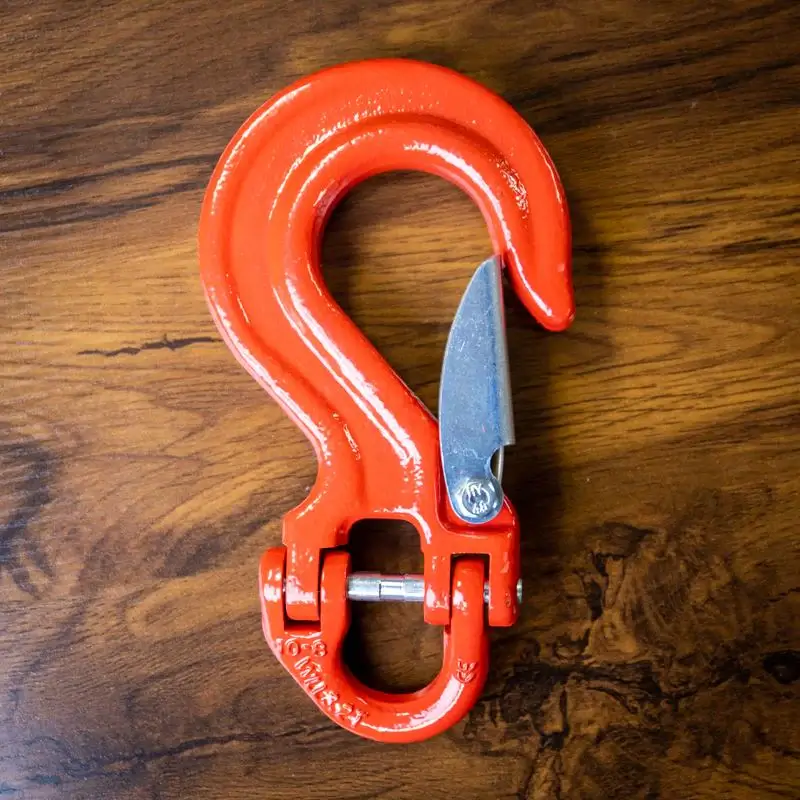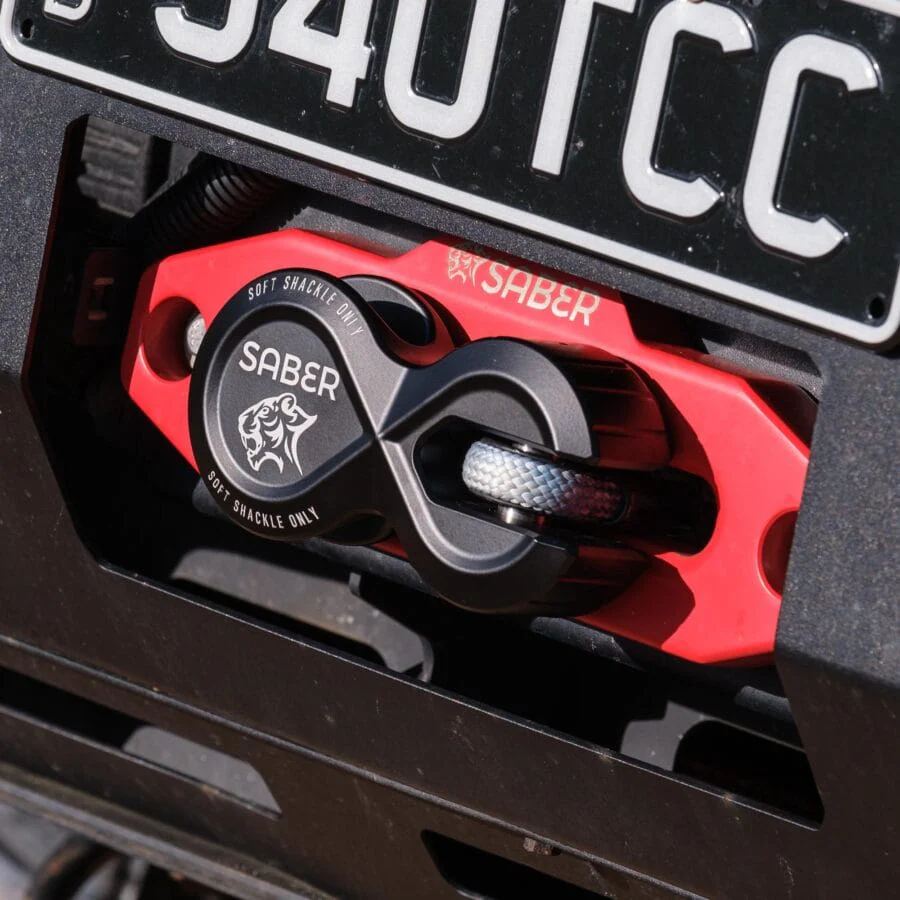A winch hook and a shackle are both essential recovery tools used in off-roading, but they serve different purposes. While winch hooks offer quick attachment and release for light to moderate pulls, shackles provide stronger, more secure connections for heavy-duty recovery scenarios.
What is the Difference Between a Winch Hook and a Shackle?
The key difference between a winch hook and a shackle is that:
- Winch Hooks are designed for quick attachment during towing and recovery operations. Winch hooks are designed for quick attachment during towing and recovery operations, featuring an open design with a safety latch for rapid use.
- Shackles provide a closed-loop connection, ideal for heavy-duty rigging and lifting operations, ensuring greater load security and even stress distribution.
What is a Winch Hook?

A winch hook is a device attached to the end of a winch line, used for pulling or lifting heavy objects. These hooks are commonly found in off-road recovery kits, towing equipment, and hauling setups.
Purpose and Use Cases
Winch hooks are primarily used in off-road recovery, towing vehicles, and hauling heavy loads. Their open design allows for quick attachment, but it also introduces potential failure points if the safety latch is not engaged properly.
They are designed to securely attach to anchor points such as tow hooks or bumpers.
Types of Winch Hooks
- Clevis Hook: Features a pin or bolt for secure attachment.
- Roller Fairlead Hook: Designed to work with roller fairleads for smooth winching operations.
- Snatch Block Hook: Used with snatch blocks to change the direction of the pull.
Key Features
- Load-Bearing Capacity: Winch hooks come with different weight ratings, so it’s important to choose one that matches your needs.
- Ease of Attachment/Detachment: These hooks are designed for quick and secure connections, making them ideal for situations where speed is essential.
What is a Winch Shackle?

A shackle is a U-shaped piece of metal secured with a pin or bolt, used to connect loads in rigging, lifting, and towing operations. They are a versatile tool in various industrial and recreational settings.
Purpose and Use Cases
People use shackles in rigging setups, lifting heavy objects, and towing. They are a critical part of closed system winching, offering a secure, fail-safe connection that minimizes risk during recovery operations.
They provide a secure connection between different components, ensuring that loads are safely and efficiently handled.
Types of Shackles
- Anchor Shackle: Also known as bow shackles, they have a larger bow to handle multiple loads.
- D-Shackle: Also called chain shackles, they have a narrow design and are used for single-point attachments.
- Bow Shackle: Similar to anchor shackles but with a more rounded shape for added flexibility.
Key Features
- Strength: Shackles are designed to handle substantial loads and are rated by their working load limit (WLL).
- Versatility: They can be used in various applications due to their robust construction.
- Security: The pin or bolt ensures a secure connection that is less likely to come loose.
Winch Hook vs. Shackle: Key Differences
Design and Construction
Winch Hooks
Crafted from high-strength steel, winch hooks are designed to quickly latch onto cables and chains, withstanding significant stress and strain.
Most winch hooks come with a safety latch, which is a small, spring-loaded mechanism that ensures the hook stays attached to the load, preventing accidental detachment.
This design is straightforward and efficient, allowing for rapid connections, a crucial feature in high-pressure situations such as urgent vehicle recovery.
Shackles
Shackles, unlike winch hooks, come in various shapes and sizes, each suited for different tasks. The most common types are D-shackles (also known as straight shackles) and bow shackles (also known as anchor shackles).
- D-Shackles: These have a straight, narrow body and are best suited for straight-line pulls.
- Bow Shackles: These have a wider, more rounded body, allowing for multi-directional loads.
Both types of shackles consist of a U-shaped body and a removable pin. This pin can be threaded or secured with a cotter pin, depending on the design.
The closed loop of shackles provides a more secure connection compared to the open form of winch hooks.
Load-Bearing Capabilities
Winch Hooks
While winch hooks are strong and capable of bearing heavy loads, their open design limits their load-bearing capacity to some extent.
The open hook can experience uneven stress distribution, especially if the load is not centered correctly. This makes them suitable for quick, temporary connections but less ideal for extremely heavy or critical loads.
Shackles
Shackles, with their closed-loop design, excel in load-bearing capacity. The U-shaped body distributes the load evenly across the shackle, reducing the risk of stress points that could lead to failure.
This design makes shackles ideal for heavy lifting and rigging operations where safety and reliability are paramount.
The pin in a shackle ensures a closed and secure connection, further enhancing its ability to handle substantial weights.
Ease of Use and Attachment
Winch Hooks
One of the standout features of winch hooks is their ease of use. The hook design allows for swift attachment and detachment, which is particularly beneficial in emergency or recovery scenarios where time is of the essence.
You simply hook the winch onto the load and secure the safety latch, and you’re ready to go. This simplicity makes winch hooks a favorite among off-road enthusiasts and tow truck operators.
Shackles
In contrast, shackles require more time to secure. To attach a shackle, you need to unscrew the pin, align the shackle with the load, insert the pin through the eye of the load, and then screw the pin back in place.
This process, while more time-consuming, ensures a very secure connection. Shackles are less convenient for tasks that require frequent attachment and detachment but are preferred for applications where a secure, long-term connection is needed.
Versatility in Applications
Winch Hooks
Winch hooks are highly versatile in specific scenarios, particularly in towing, recovery, and hauling. Their quick attachment capability makes them ideal for situations where you need to move fast.
They can be easily hooked onto various anchor points, such as vehicle frames, tow hooks, and eyelets.
This versatility makes them a valuable tool for anyone involved in off-road adventures or roadside assistance.
Shackles
Shackles offer broader versatility across different industries. They are essential in rigging and lifting operations, providing secure connections for lifting heavy loads with cranes or hoists.
Shackles are also used in securing loads for transport, ensuring that heavy equipment or goods remain safely attached during transit.
Their ability to provide both temporary and permanent connections makes them indispensable in construction, maritime, and industrial settings.
Safety Considerations
Winch Hooks
Safety is a critical factor when using winch hooks, especially during momentary slack conditions where the load may shift unexpectedly. In contrast, shackles provide a redundant safety mechanism due to their closed-loop design.
While they are convenient, their open design can pose risks if not properly latched or if the load shifts unexpectedly.
The safety latch is a crucial feature, but users must ensure it is always engaged correctly. Regular inspection for signs of wear, such as cracks or deformation, is essential to prevent accidents.
Shackles
Shackles provide a more secure connection, which enhances safety, especially under heavy loads. The closed-loop design and the secure pin reduce the risk of accidental detachment, even if the load shifts.
However, it’s equally important to regularly inspect shackles for wear and tear. Look for any signs of corrosion, thread damage on the pin, or deformation of the shackle body.
Using shackles that are rated for the specific load and environment is crucial for maintaining safety standards.
When to Use a Winch Hook
Off-Road Recovery Situations
Winch hooks are particularly useful in off-road recovery scenarios. Imagine your vehicle is stuck in mud or snow, and you need to get it out quickly.
The design of the winch hook allows for fast attachment to recovery points, which is crucial when you’re in a hurry.
The hook can be latched onto a recovery strap or another vehicle in seconds, allowing for a swift and effective recovery operation.
Towing and Hauling Heavy Loads
When it comes to towing and hauling, winch hooks prove their worth. They can easily attach to the tow points of trailers, vehicles, and other heavy objects.
The robust design ensures they can handle significant loads, making them ideal for moving heavy equipment, vehicles, or large objects.
The ease of attachment means you can quickly secure the load and get on the road, saving time and effort.
Situations Requiring Quick Attachment/Detachment
In emergency situations where speed is crucial, winch hooks are invaluable. Whether you’re dealing with a stuck vehicle, an urgent tow, or a quick haul, the simplicity and speed of attaching and detaching a winch hook can be a game-changer.
This feature is especially useful for first responders, off-roaders, and anyone who needs to act quickly in critical situations.
When to Use a Shackle
Rigging and Lifting Operations
Shackles are essential in rigging and lifting operations. Their secure, closed-loop design ensures that heavy loads are lifted safely.
For example, in construction, shackles are used to connect lifting slings to heavy beams or machinery. The shackle’s pin locks in place, providing a secure connection that can handle the load’s weight without risk of detachment.
Securing Loads for Transport
Transporting heavy equipment or goods requires a secure connection, and shackles are perfect for this task.
When loading items onto a trailer or securing cargo for a long journey, shackles provide a reliable way to ensure everything stays in place.
Their ability to handle high weights and maintain a secure hold makes them ideal for transport applications, preventing loads from shifting or falling during transit.
Permanent or Semi-Permanent Connections
For connections that need to stay secure over an extended period, shackles are the preferred choice. Their sturdy construction and the pin’s secure locking mechanism make them suitable for permanent or semi-permanent connections.
For instance, shackles are often used in maritime settings to secure lines and chains that must withstand harsh conditions without frequent adjustments. Their durability and reliability make them ideal for long-term applications.
Choosing the Right Component
When choosing between a winch hook and a shackle, consider the intended use, load capacity, and the environment in which you’ll be using the component. Think about whether you need quick attachment or a more secure, long-term connection.
Compatibility with Existing Equipment
Ensure that the component you choose is compatible with your existing equipment. Mismatched equipment can lead to failure and pose safety risks.
Consulting Professionals for Complex Applications
For complex applications or if you’re unsure which component to use, consulting with professionals can provide valuable insights and ensure that you choose the right tool for the job.
Safety Precautions
Importance of Using Appropriate Rigging Components
Always use components that are rated for the loads you are working with to prevent accidents and equipment failure.
Inspecting for Wear and Damage
Regularly check your winch hooks and shackles for signs of wear, corrosion, or damage. Replace them if any issues are found.
Following Manufacturer’s Guidelines and Weight Ratings
Adhere to the manufacturer’s instructions and never exceed the weight ratings to ensure safe and efficient operations.
Conclusion
Understanding the differences between winch hooks and shackles such as their design, load capacity, and failure points can help you make informed decisions for recovery operations and rigging tasks and ensure the safety and efficiency of your operations.
Whether you need the quick attachment of a winch hook or the secure connection of a shackle, knowing when and how to use each component is crucial.
Always consider the specific needs of your task and consult with professionals if necessary to ensure you’re using the right equipment for the job.

